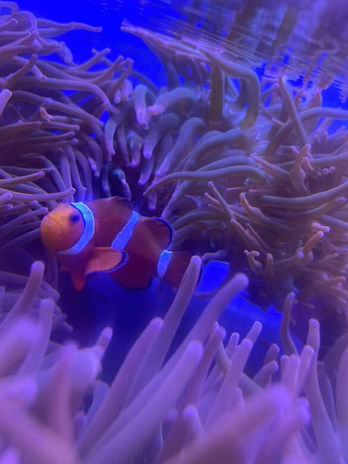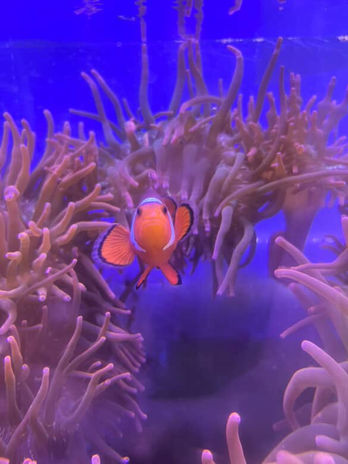Ocellaris Clownfish
(Amphiprion Clownfish)
Conservation Status: Not currently threatened, least concern
Have you found Nemo yet? Our Ocellaris clownfish, most commonly known for being the clownfish species in the hit Disney Movie Finding Nemo, is one of 3 species found in our warm water tanks. The Amphiprion Clownfish, also known as the common clownfish or percula clownfish is a member of the pomacentridae family, which includes clownfish and damselfish. The classic ocellaris clownfish is most commonly recognized by its bright orange and white stripe pattern, but there are also many different species such as the Snowflake Clownfish that are color variations of the classic ocellaris. The ocellaris clownfish grows between 4cm and 10cm. They are native to warm waters in the indo-pacific region.
The ocellaris clownfish is omnivorous, essentially eating whatever they can find. Since they form symbiotic relationships with anemones, they often eat food that becomes stuck to their hosts’ tentacles, and sometimes even take bites of the tentacles themselves. When they don’t get their food from their host anemone in the wild, they feed on zooplankton, fish eggs, copepods, shrimp algae and other small organisms. Clownfish have a wide diet variety, and are not very picky, so when kept in captivity they can feed on different foods such as flakes, brine, and cubes such as mysis, and krill.
Ocellaris clownfish can be found in the wild, living alone, in pairs or in groups. They can be territorial or aggressive animals and they rarely travel more than 30cm from their host anemone. Ocellaris clownfish are defensive and protective over their anemone, and their aggressive behaviors include tail beating, chasing, and biting intruding animals. When they are not in defense mode, ocellaris clownfish can be found cleaning their anemone, removing debris and waste from its oral disc, and providing nitrogenous waste that the anemone uses as food. In the wild under the protection of their host anemone, ocellaris clownfish typically live up to 8 years. Their life span is extended to approximately 12 years in captivity.
Fun Facts:
Female ocellaris clownfish lay their eggs near anemones, they are then fertilized and cared for by the father.
Ocellaris clownfish are hermaphrodites, meaning they mature as males but they have the ability to change their gender to female, typically if their female breeding pair dies.
Juvenile ocellaris clownfish are adapted to be able to locate their parents' host anemone by their sense of smell.
Ocellaris Clownfish are most commonly hosted by bubble tip anemones.
%20(1).jpg)

